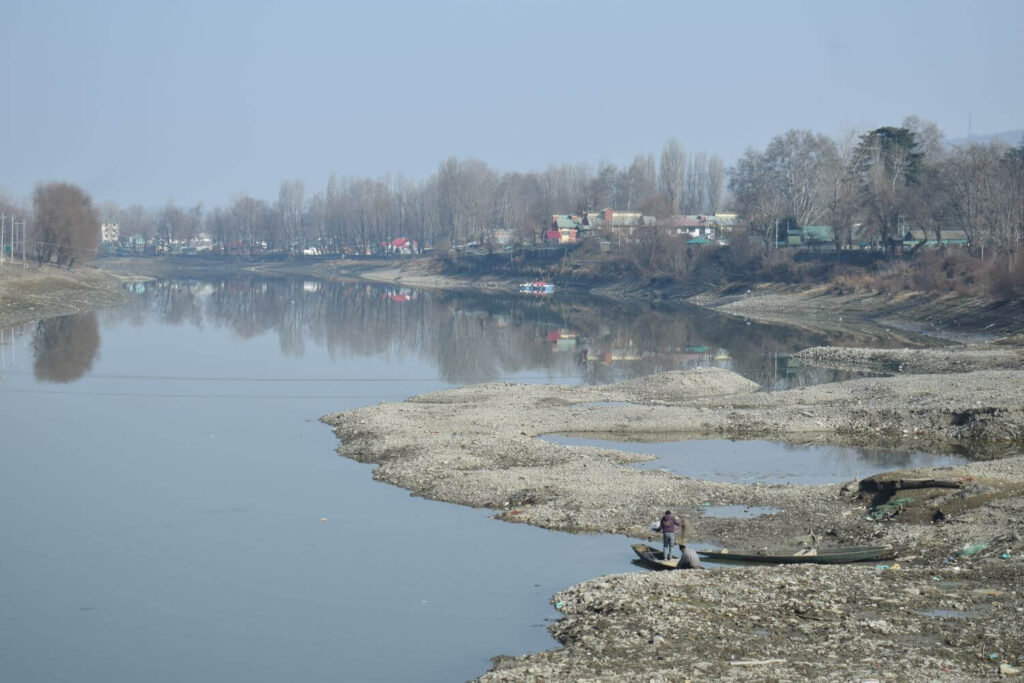The Himalayas span 2,500 kilometers (1,550 miles) across South Asia. The region is home to over 50 million people and provides water to 2 billion people in a region spanning the densely populated North of the Indian subcontinent and areas beyond the subcontinent such as Myanmar and Tibet. These people rely on Himalayan glacier water for drinking water, energy and agriculture — as do diverse ecosystems of flora and fauna downstream.
Now, this vital resource is under threat. Due to climate change, temperatures are rising and precipitation is declining. The snow- and rainfall that normally build up the glaciers in wintertime are insufficient to make up for the summer melt. This has caused the glaciers to shrink, threatening the downstream communities that rely on the summer flows.

The water levels of the Jhelum River are getting shockingly low. Author’s photo.
Many areas down the slopes are particularly feeling the pinch. The northwestern Indian union territory of Jammu and Kashmir, which relies on its famously scenic mountain landscapes to draw in tourists from the rest of the country, is now facing economic pressure.
The Himalayas are drying up
According to an analysis by the US National Oceanic and Atmospheric Administration’s National Centers for Environmental Information, 2023 saw the warmest global temperatures since records began. The heat has put strain on water resources across the world. The Himalayas are no exception.
A May 2022 study conducted by Zahid Majeed and Muneer Mukhtar of the Geological Survey of India along with Manish Mehta of the Wadia Institute of Himalayan Geology, revealed that the Kolahoi glacier has lost 23% of its area since 1962 and has fragmented into small parts. The glacier is the main source of the Jhelum River, which originates in Jammu and Kashmir and waters a part of the Punjab region of Pakistan.

Low water levels in the Jhelum River. Author’s photo.
A March 2022 study published in Environmental Science and Pollution Research on 77 glaciers in Drass, a cold desert region in the western Himalayas, reveals that the total glacier area shrunk by 5.32 square kilometers between 2000 and 2020. The study attributes the melting to increased greenhouse gas emissions and pollutants including black carbon.
Francesca Pellicciotti of the Institute of Science and Technology Austria explains that glaciers can “fight back” against global warming, at least for a little while. The increased temperature difference between the cold mountain air and the warmer incoming air creates increased turbulence. This, paradoxically, increases the rate at which the glaciers cool the surrounding air and creates cold winds that can protect the glacial surface. However, this short-term benefit is offset by another effect. As the cold air sinks and blows down the mountain surface, it pushes storms down as well and causes precipitation to occur at lower altitudes. This hinders snowfall from replenishing the glaciers. “Thus, perceived cool temperatures flowing down from glaciers are an emergency reaction to global warming rather than an indicator of glacier long-term stability.”
Changing wind patterns also play a role in the decreased rainfall. Normally, storms called western disturbances bring large amounts of rainfall to the Himalayas. Wind coming from the West picks up moisture over the Mediterranean. The airmass then drops the water when it hits the Himalayas. In recent years, however, the frequency of these storms has declined by 43%.
A 2019 study conducted by the American Meteorological Society found that the diminishing frequency and intensity of western disturbances would result in a 15% reduction in mean winter rainfall over northern India.
Scientists say that the situation in the Himalayas could still get a lot worse, putting additional pressure on the region’s already strained irrigation and hydropower systems.
The mountain paradise of Kashmir is looking shabby in the heat
The Kashmir valley, which lies between the Himalayan slopes in Jammu and Kashmir (J&K), is among those regions experiencing hardship. In 2023, Srinagar, J&K’s summer capital, recorded its hottest June in 18 years. On June 23 it witnessed a peak of 35.0° C (95° F). On the same day, Qaxigund recorded its second-highest temperature in 33 years at 34.2°C (93.6° F). Similarly, other well-known tourist destinations like Kokernag and Pahalgam broke records last June.

Gulmarg, Kashmir, a well-known ski resort, without snow. Author’s photo.
In the winter of 2023–2024, the vital annual rainfall was weak. The Kashmir Meteorological Department recorded Srinagar’s driest January in 58 years. Furthermore, the annual “Chillai-Kalan” the traditionally harsh 40-day winter period ending on January 29, saw the driest conditions in Srinagar since 2015.
According to independent weather expert Faizan Aarif, J&K experienced a 7% deficit in rainfall in the past winter. The region received 1,146.6 millimeters of precipitation, significantly beneath the average of 1,232.3 millimeters.
I spoke to Aarif to learn more. “Winter snowfall is important for the Kashmir valley, as it freezes on the mountains and provides water for horticulture and agriculture in the summers when it melts. If there is a deficit, it will hit crop production in the valley,” he told me.
Shakil A. Romshoo, a prominent glaciologist and climate change researcher, told me more about the situation. Romshoo expressed concern over below-average winter snowfall and an extended dry spell in Kashmir. He warns of potential water shortages in summer, impacting water-intensive paddy cultivation.

A fisherman struggles in the low waters of Wular Lake, Kashmir. Author’s photo.
I also spoke to Suhaib A. Bandh, an assistant professor of environmental science. He highlighted the diverse and significant potential consequences of the drying, including threats to Kashmir’s lakes, rivers and ecosystems.
This spring, I traveled to the lakeside village of Laharawalpora and spoke to Mohammed Sultan, 43, a local fisherman. He told me that “the dry winter has affected our livelihood as the fish catch and chestnut production have decreased. The banks where we extract chestnuts in the winter have dried up. The lake is at a historic low level, and this will affect the future production as the seeds have also dried up on the banks.”

A fisherman’s boat stuck in a dry lake bottom. Author’s photo.
Special prayers have been held in several parts of Kashmir as the people fear that the absence of snowfall in the region will affect crop production and lead to water and food scarcity in the summer months.
The dry weather is affecting more than just the fishing and agricultural industries. With the high temperatures, many of Kashmir’s gorgeously snow-capped peaks are now bald. Millions of tourists visit J&K every year to view its renowned landscapes. Now, famous tourist destinations like Gulmarg and Pahalgam are strangely empty. The valley saw 80% of its bookings canceled this winter.
If the weather does not change soon, these Himalayan vacation paradises may soon become ghost towns.
[Aniruddh Rajendran edited this piece.]
The views expressed in this article are the author’s own and do not necessarily reflect Fair Observer’s editorial policy.
Support Fair Observer
We rely on your support for our independence, diversity and quality.
For more than 10 years, Fair Observer has been free, fair and independent. No billionaire owns us, no advertisers control us. We are a reader-supported nonprofit. Unlike many other publications, we keep our content free for readers regardless of where they live or whether they can afford to pay. We have no paywalls and no ads.
In the post-truth era of fake news, echo chambers and filter bubbles, we publish a plurality of perspectives from around the world. Anyone can publish with us, but everyone goes through a rigorous editorial process. So, you get fact-checked, well-reasoned content instead of noise.
We publish 2,500+ voices from 90+ countries. We also conduct education and training programs
on subjects ranging from digital media and journalism to writing and critical thinking. This
doesn’t come cheap. Servers, editors, trainers and web developers cost
money.
Please consider supporting us on a regular basis as a recurring donor or a
sustaining member.
Will you support FO’s journalism?
We rely on your support for our independence, diversity and quality.










Comment